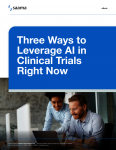Bioprocess International
Pharma manufacturers using smart glasses for virtual POV

Angelo Stracquatanio, a co-founder of US company Apprentice Field Suite, said his firm has licensed its recently launched software to four top-ten pharma companies as well as a major CMO and biotech.
The technology has many applications, allowing experts off-site to see exactly what production workers wearing the smart glasses can see, and allowing workers to project guidance documents and safety data onto their lenses.
The makers say the tech can be used in pharma manufacturing for troubleshooting, human error prevention, quality control, productivity and efficiency increases, and safety, said Stracquatanio. The four software services are designed to run on interchangeable hardware created by various smart glasses companies.
Efficiency savings and ‘quality of life’
Stracquatanio says he founded the company with a process engineer who complained she was tired of having to respond to weekend calls about problems in the manufacturing suite by driving to the site: “Meanwhile the facility is down, and it’s a quality of life issue for her.”
The company’s solution – and its most popular licence – is a “telepresence” app named Tandem, which allows a supervisor working remotely to see what an operator wearing glasses is doing in real-time. The person off-site can communicate by voice and draw in the operator’s field of vision to point out critical errors.
Another offering allows workers to access standard operating procedures (SOPs) via their glasses, turning pages or watching videos with either a wave of the hand or voice command. This method avoids the possibilities for error associated with using paper SOPs – like printing off the wrong version – and frees up the operator’s hands for her task. Many operators end up working from memory because holding a binder while operating machinery is too cumbersome, said Stracquatanio.
He gave the example of a tired worker at the end of his shift pulling the sparger out of a bioreactor and dumping a whole batch on the floor – “the guy didn’t see the lock-out tag and realise it was in use.”
A third safety and data tool can issue warnings, for instance warning the wearer when she looks at a bioreactor that it is in use. It also creates an audit trail: “if something goes wrong, you can ask why they did that.”
The same software can interpret analogue gauges and feed them into reporting systems without the need for human transcribing.
A fourth app, launched at Bioprocess International conference in Boston this week, tracks employee movements around a facility so companies can better design layout. Stracquatanio told us the data is aggregated and cannot be used to track individual employees’ movements.
Strategic partnerships
Stracquatanio said the Tandem tool can be used by CMOs so clients can collaborate more closely, even “checking the size of granulated powder before it gets pressed while the worker has it in their hand.”
Co-founder Gary Pignata told us customers like using the remote monitoring because it saves the expense of flying their representatives out to CMO facilities, while outsourcing partners don’t miss the disruption of showing visitors around a working site. A virtual tour also means pharma companies are unlikely to accidentally see their rivals’ production lines, he added.















